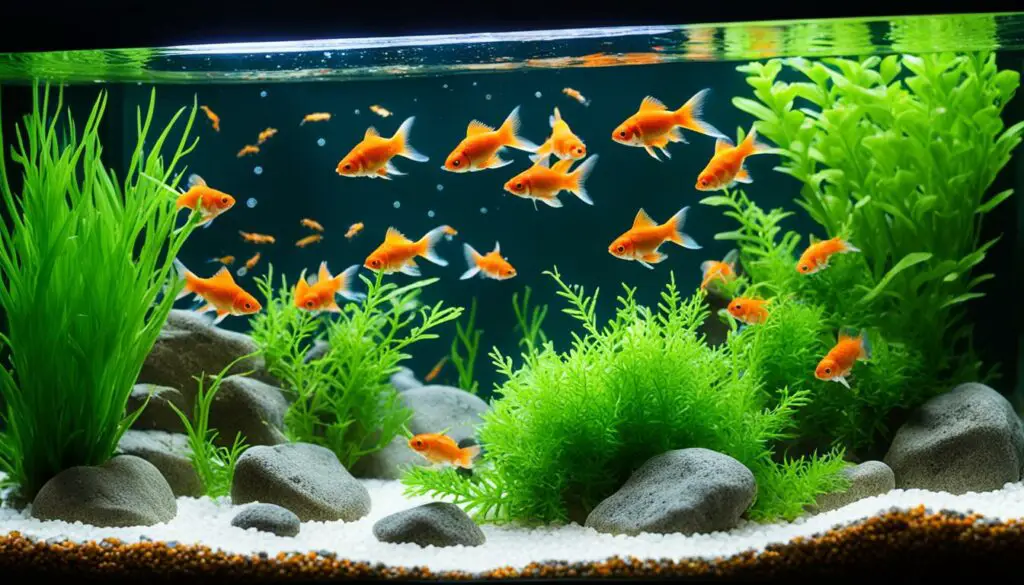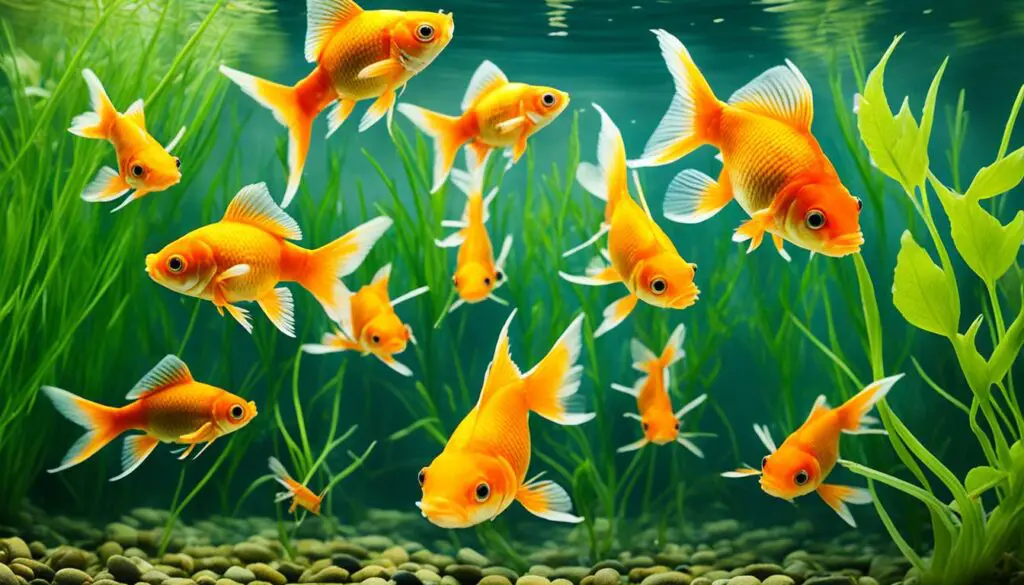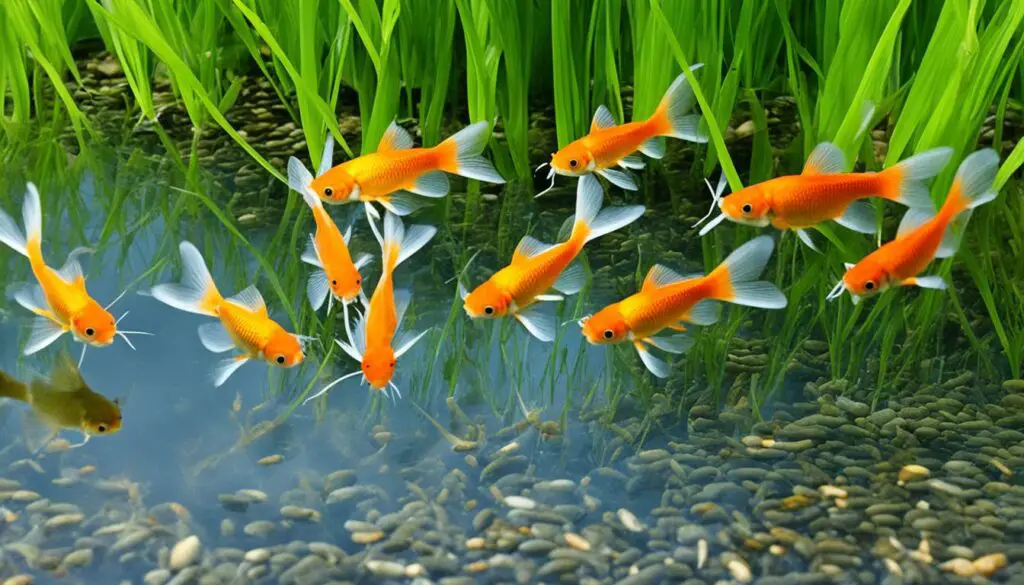Last Updated on 2 weeks by admin
Do you have a mosquito problem? Are you wondering if goldfish can help control mosquito populations? Look no further! We have all the information you need about goldfish and their appetite for mosquito larvae.
Mosquitoes can be a nuisance, not to mention the potential health risks they pose with diseases like the West Nile virus. Fortunately, goldfish can be a natural solution to combat these pesky insects. These beautiful aquatic creatures are voracious eaters and have an appetite for mosquito larvae.
Whether you have fancy, comet, or common goldfish, they all have the potential to devour mosquito larvae. However, smaller goldfish may have an advantage due to their size.
Key Takeaways:
- Goldfish are effective in controlling mosquito populations by consuming mosquito larvae.
- Any type of goldfish can eat mosquito larvae, although smaller ones may have an advantage.
- Other fish species that eat mosquito larvae include mosquito fish, minnows, koi, and guppies.
- Using goldfish for mosquito control is a natural and cost-effective alternative to chemical insecticides.
- Maintaining clean and healthy water conditions in goldfish tanks is important to prevent mosquito larvae from appearing.
Mosquito Larvae and Goldfish Diet

Mosquito larvae can be part of a goldfish’s diet. Goldfish are omnivorous and feed on a variety of sources, including insects, plants, and small organisms. Mosquito larvae provide a natural food source for goldfish and can contribute to their overall nutrition.
However, goldfish should not rely solely on mosquito larvae for their diet and should be fed a balanced commercial fish food as well. This ensures that they receive all the necessary nutrients and vitamins for their growth and well-being.
Feeding goldfish a varied diet is important to maintain their health. In addition to commercial fish food, goldfish can be given small amounts of other foods such as vegetables, fruits, and live or frozen foods like brine shrimp or daphnia.
While mosquito larvae can be a supplemental source of food, it should not replace a balanced diet. Goldfish require a mix of proteins, carbohydrates, fats, vitamins, and minerals to thrive.
Observing goldfish feeding on mosquito larvae can be an interesting and educational experience. It showcases their natural behavior as predators and their ability to contribute to mosquito control in outdoor ponds or water gardens.
Comparison of Goldfish Diet and Mosquito Larvae Nutritional Content
| Component | Goldfish Diet | Mosquito Larvae |
|---|---|---|
| Protein | Varied, including fish meal, algae, and plant protein | Approximately 48-60% |
| Fat | Varied, from vegetable oils and fish oil | Approximately 16-22% |
| Vitamins | Enriched with essential vitamins | Minimal vitamin content |
| Minerals | Contains essential minerals | Minimal mineral content |
The table above provides a comparison of the nutritional content between a goldfish diet and mosquito larvae. While mosquito larvae have high protein and fat content, they may lack essential vitamins and minerals that are typically found in commercial fish food.
“A balanced diet is crucial for goldfish to thrive and maintain optimal health. While mosquito larvae can be a valuable food source, they should not be the sole component of a goldfish’s diet.” – Dr. Jane Peterson, Aquatic Biologist
Goldfish owners should monitor their fish’s diet and consult with aquatic experts or veterinarians to ensure they are providing a nutritionally balanced and appropriate diet for their goldfish.
The Role of Mosquitoes in Goldfish Tanks

Mosquito larvae can sometimes be found in goldfish tanks if there is stagnant water or poor water circulation. While goldfish may consume mosquito larvae, proper maintenance is crucial to ensure clean and healthy water conditions in the tank. Regular tank cleaning, along with adequate filtration and aeration, can help prevent the appearance of mosquito larvae in goldfish tanks.
Mosquitoes are attracted to stagnant water sources, where they lay their eggs. If a goldfish tank has inadequate water circulation or if the water is left unchanged for extended periods, mosquito larvae may develop.
It is important to note that goldfish feeding habits include mosquito larvae as part of their natural diet. However, relying solely on mosquito larvae as a food source may not meet their nutritional needs. Goldfish should also be fed a balanced commercial fish food to ensure optimal health and growth.
Proper tank maintenance not only prevents the growth of mosquito larvae but also promotes a healthy environment for goldfish. Filtration systems help clear debris and maintain water quality, while aeration provides oxygen necessary for goldfish survival.
In summary, while goldfish can eat mosquito larvae, mosquito presence in goldfish tanks should be minimized through regular cleaning, proper filtration, and adequate aeration. By maintaining clean and healthy water conditions, goldfish can thrive while contributing to natural mosquito control.
Giving goldfish a suitable environment ensures their well-being and reduces the risk of diseases associated with poor water quality. By following best practices in goldfish care, including mosquito control, tank owners can provide a safe and thriving habitat for their fish.
Tips for Maintaining a Healthy Goldfish Tank:
- Perform regular water changes to remove any accumulated waste or toxins.
- Use a reliable filtration system to keep the water clean and free from debris.
- Aerate the tank to ensure an adequate oxygen supply for goldfish.
- Monitor water temperature to maintain an optimal range for goldfish health (between 65-75°F).
- Keep the tank free from excessive algae growth to prevent oxygen depletion.
By following these tips and maintaining proper tank conditions, goldfish owners can create a thriving environment for their fish while minimizing the presence of mosquito larvae.
Benefits of Using Goldfish for Mosquito Control

Using goldfish as a natural method of mosquito control offers several benefits. Not only are goldfish environmentally friendly, but they can also effectively reduce mosquito populations without the need for chemical insecticides. Let’s explore the advantages of incorporating goldfish into your mosquito control strategy:
1. Environmentally Friendly
Unlike chemical insecticides that can harm the environment and other beneficial organisms, goldfish provide a safe and eco-friendly solution for mosquito control. They are a natural predator of mosquito larvae, making them an ideal choice for those seeking a non-toxic alternative.
2. Cost-Effective Solution
Investing in goldfish for mosquito control is a cost-effective solution compared to purchasing chemical insecticides or other mosquito control products. Once the goldfish are introduced to the water source, they continue to feed on mosquito larvae, providing long-term protection without the need for additional purchases.
3. Minimal Maintenance
Goldfish are relatively low-maintenance creatures, requiring minimal care and attention. Unlike other mosquito control methods that may involve regular applications or treatments, goldfish simply need a suitable habitat with clean water and proper nutrition. Regularly feeding them a balanced diet and ensuring a clean environment will help maintain their effectiveness in controlling mosquito populations.
4. Visual Appeal
In addition to their practical benefits, goldfish also add aesthetic value to ponds or water gardens. Their vibrant colors and graceful movements can enhance the beauty of any aquatic setting. With goldfish as part of your mosquito control strategy, you can enjoy both a visually appealing environment and reduced mosquito populations.
5. A Natural Solution
Goldfish are a natural fit for mosquito control, as they instinctively consume mosquito larvae as part of their diet. By allowing these fish to thrive in bodies of water prone to mosquito breeding, you can harness their natural predation instincts to control mosquito populations without the use of chemicals or harmful methods.
By utilizing goldfish for mosquito control, you can embrace a natural and eco-friendly approach while effectively managing and reducing mosquito populations in your surroundings.
Continue reading to discover other natural predators of mosquito larvae and additional tips for controlling mosquito populations.
Other Predators of Mosquito Larvae

In addition to goldfish, there are several other fish species and natural predators that feed on mosquito larvae, providing effective natural mosquito control. These predators include:
- Mosquito fish
- Minnows
- Koi
- Guppies
These fish species actively consume mosquito larvae, helping to disrupt the mosquito lifecycle and reduce mosquito populations. However, it’s important to note that not all fish species are suitable for cohabitation in the same tank or pond, as they may have different environmental and dietary requirements.
Furthermore, it’s not just fish that play a role in controlling mosquito populations. Other natural predators of mosquito larvae include:
- Dragonflies
- Slider turtles
- Some bat species
- Some bird species
Having a diverse range of predator species in an ecosystem can contribute to effective mosquito control, as each predator may target mosquitoes at different stages of their lifecycle.
| Predator | Prey |
|---|---|
| Goldfish | Mosquito larvae |
| Mosquito fish | Mosquito larvae and other small aquatic insects |
| Minnows | Mosquito larvae and other small aquatic organisms |
| Koi | Mosquito larvae and other small aquatic invertebrates |
| Guppies | Mosquito larvae and other small aquatic organisms |
| Dragonflies | Mosquito larvae and adult mosquitoes |
| Slider turtles | Mosquito larvae and other small aquatic organisms |
| Some bat species | Adult mosquitoes and other flying insects |
| Some bird species | Adult mosquitoes and other small insects |
By promoting the presence of these natural predators, such as goldfish and other fish species, in aquatic environments, we can achieve effective and eco-friendly mosquito control.
Life Cycle of Mosquitoes and Mosquito Larvae
Mosquitoes go through a four-stage life cycle, with the egg, larvae, pupa, and adult stages. Understanding the life cycle of mosquitoes and their larvae is crucial in implementing effective mosquito control measures.
Mosquito larvae life cycle:
- Egg: Female mosquitoes lay their eggs on the surface of stagnant water or in areas prone to flooding. These eggs can survive dry conditions and hatch when exposed to water.
- Larvae: The hatched eggs develop into mosquito larvae, commonly known as wrigglers. These larvae reside in the water and feed on microorganisms like bacteria, fungi, and algae.
- Pupa: After a period of growth, the mosquito larvae enter the pupal stage. During this stage, the larvae transform into pupae and remain near the water’s surface.
- Adult: The pupae complete their development and emerge as adult mosquitoes. They leave the water and take flight, seeking mates and sources of nutrition, including blood from animals or nectar from plants.
Mosquito larvae development occurs in stagnant water sources such as ponds, lakes, discarded tires, and containers with standing water. It is important to eliminate these water sources to prevent mosquitoes from breeding and interrupt their life cycle.
Tips for Controlling Mosquito Populations
To effectively control mosquito populations and prevent their breeding, it is crucial to take proactive measures. By eliminating stagnant water sources and introducing natural mosquito predators, you can create an environment that discourages mosquito breeding.
Preventing Mosquito Breeding
- Empty and Clean Water Collecting Containers: Ensure that containers such as buckets, birdbaths, and flower pots are regularly emptied and cleaned to remove any standing water. This eliminates potential breeding grounds for mosquitoes.
- Use Solar or Submersed Aerators: Installing solar-powered or submersed aerators helps keep water moving, preventing it from becoming stagnant. This disruption in water flow makes it less favorable for mosquitoes to lay their eggs.
- Stock Ponds with Mosquito Predators: Introducing natural mosquito predators like goldfish, mosquito fish, or minnows to your ponds or water features can contribute to effective mosquito control. These fish species feed on mosquito larvae, reducing their population naturally.
By implementing these preventive measures, you can significantly reduce the likelihood of mosquito breeding in your surroundings, creating a safer and more enjoyable outdoor environment.
“Controlling mosquito populations through prevention is a sustainable and environmentally-friendly approach. By eliminating breeding grounds and introducing natural predators, you can effectively manage mosquito populations without relying on chemical insecticides.”
Other Mosquito Control Methods
While goldfish can play a role in mosquito control, there are additional methods that can effectively manage mosquito populations. These methods, when combined with natural control techniques, can help create a comprehensive approach to mosquito control.
1. Use of Insect Repellents
One of the easiest and most accessible methods of mosquito control is using insect repellents. Apply EPA-approved repellents to exposed skin or clothing to deter mosquitoes from biting. Common active ingredients in repellents include DEET, picaridin, and IR3535. Always follow the instructions on the product label for safe and effective use.
2. Installation of Mosquito Nets or Screens
Mosquito nets or screens can be installed on windows, doors, and outdoor areas to create barriers that keep mosquitoes out. These protective barriers allow for ventilation while preventing mosquitoes from entering the living spaces. It is particularly important to ensure that screens are properly fitted and free from any tears or gaps.
3. Removal of Standing Water
Mosquitoes require standing water to breed, so it is essential to remove any sources of stagnant water around your property. Regularly empty and clean containers like buckets, flower pots, or birdbaths that can collect water. Ensure that gutters are clear of debris to prevent water accumulation. By eliminating standing water, you can significantly reduce mosquito breeding sites.
4. Integrated Pest Management Strategies
Integrated pest management (IPM) strategies involve using a combination of techniques to target specific pests while minimizing environmental impacts. In the case of mosquito control, larvicides can be applied to standing water to kill mosquito larvae. Biological controls, such as using bacteria or fungi, can also be employed to disrupt the mosquito life cycle. These approaches can provide effective and targeted control of mosquito populations.
“Integrating multiple methods for mosquito control can enhance effectiveness and provide long-term solutions.”
By combining the use of insect repellents, installing protective barriers, eliminating standing water, and employing integrated pest management strategies, you can create a multi-faceted approach to mosquito control. This approach can help reduce mosquito populations and minimize their impact on your outdoor activities and overall well-being.
Conclusion
Goldfish can indeed eat mosquito larvae and contribute to natural mosquito control. They are effective in controlling mosquito populations, along with other fish species and natural predators of mosquito larvae. This natural approach to mosquito control can help reduce the use of chemical insecticides and promote a healthier environment.
However, it is crucial to maintain clean and healthy water conditions in goldfish tanks to ensure their well-being and optimal mosquito control. Regular tank maintenance, such as cleaning and proper filtration, is essential to prevent mosquito larvae from appearing in the tank.
While goldfish can play a significant role in mosquito control, it is important to consider other methods as well. Preventive measures like eliminating stagnant water sources and using insect repellents can help control mosquito populations. Additionally, biological controls like bacteria or fungi can target mosquito larvae effectively.
By combining preventive measures and natural control methods, it is possible to minimize the presence of mosquitoes and reduce their impact on human health. With proper care and management, goldfish can be valuable allies in the fight against mosquitoes.
FAQ
Will goldfish eat mosquito larvae?
Yes, goldfish can consume mosquito larvae, making them effective in controlling mosquito populations.
Can mosquito larvae be part of a goldfish’s diet?
Yes, mosquito larvae can be part of a goldfish’s diet, as goldfish are omnivorous and feed on a variety of sources.
Can mosquito larvae be found in goldfish tanks?
Yes, mosquito larvae can sometimes be found in goldfish tanks if there is stagnant water or poor water circulation.
What are the benefits of using goldfish for mosquito control?
Using goldfish for mosquito control offers several benefits, including being an environmentally-friendly alternative to chemical insecticides and requiring minimal maintenance.
Are there other fish species that feed on mosquito larvae?
Yes, other fish species that also eat mosquito larvae include mosquito fish, minnows, koi, and guppies.
What is the life cycle of mosquitoes and mosquito larvae?
Mosquitoes go through a four-stage life cycle, with the egg, larvae, pupa, and adult stages. Mosquito larvae feed on bacteria, fungi, and algae in stagnant water sources.
What are some tips for controlling mosquito populations?
To control mosquito populations, it is important to prevent their breeding by eliminating stagnant water sources and stocking ponds or water features with mosquito predators.
What are other mosquito control methods?
Other mosquito control methods include using insect repellents, installing mosquito nets or screens, and employing larvicides or biological controls like bacteria or fungi.
Source Links
- https://animals.mom.com/types-goldfish-eat-mosquitoes-9050.html
- https://www.solitudelakemanagement.com/what-kind-of-fish-eat-mosquito-larvae/
- https://permies.com/t/218432/grow-mosquitoes-feed-goldfish


